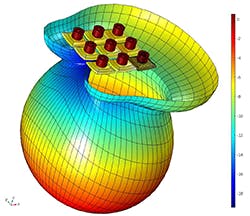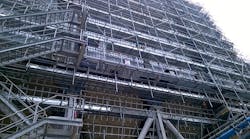Comsol releases the latest version of the Comsol Multiphysics and Comsol Server products, Version 5.3a. The new version reportedly provides simulation specialists with advanced modeling tools and increased solver performance:
Hybrid Boundary Element-Finite Element Method for Acoustics
Comsol 5.3a offers acoustics analysis based on the boundary element method. Acoustic engineers can analyze the full range of acoustic frequencies from the lowest bass notes to ultrasound, in addition to all of the possible multiphysics couplings available in the software.
New Modeling Tools, Faster Solvers, Better Visualization
A framework for model reduction is available with the release of two methods, modal analysis and asymptotic waveform evaluation (AWE), for the reduction of the computational complexity of mathematical models. Customers using LiveLink for MATLAB can get access to reduced models through a dedicated state-space export function. Many customers, especially those involved with computational fluid dynamics (CFD) analysis, will experience up to 40% improved performance for algebraic multigrid (AMG) and 20% for geometric multigrid (GMG) solvers, according to the company. Support for 3Dconnexion SpaceMouse devices makes model navigation easier. The color table Cividis, optimized for people with color vision deficiency, is now available for visualization of field quantities.
Thermodynamics Properties Library, New Turbulence Model, and Moisture Flow Multiphysics Coupling
A built-in library for thermodynamics properties features models for gases, liquids and phase equilibria (gas-liquids). There is a new realizable k-? turbulence model available for a more accurate description of fluid flow features. A predefined multiphysics coupling is introduced for the modeling of heat and moisture transport in building materials and moist air.
Method for Plasma Simulations, BEM for Magnetic Field Analysis
A new method for modeling capacitively coupled plasmas (CCP), based on a non-linear time-periodic formulation, reduces solution times of CCP simulations from weeks to hours, according to the company. Those working in electromagnetics can now use the boundary element method to analyze magnetic fields in models with large volume-to-surface ratio, including infinite domains, with great accuracy.
New Shape Memory Alloy Material Models and 3D Solid-Beam Connections
Engineers designing smart metal devices, from biomedical to consumer products, can now include a shape memory alloy (SMA) material in their simulations. A SMA material can be coupled to other physics such as heat transfer. Users will benefit from a solid-beam connection feature as well as a new technique to model thread forces for bolts using a dedicated type of contact pair boundary condition.
Rendering in Simulation Apps, New Publishing and Administration Features
Apps with very large plots or many graphics windows will see improved rendering performances resulting in a more responsive user interface. Comsol Server users can login without a password within their corporate network. The thumbnail image and description for an app can now be changed directly through the Comsol Server web interface. Administrators can send global notifications to all users, for example, if the server needs to shut down for maintenance. There is a new cluster verification app installed by default in Comsol Server that allows administrators to test cluster settings more conveniently. This app is also available in a regular Comsol Multiphysics installation for floating network licenses.
Comsol Multiphysics and Comsol Server software products are supported on Windows operating system, Linux operating system, and macOS operating system. The Application Builder is supported in the Windows operating system.




